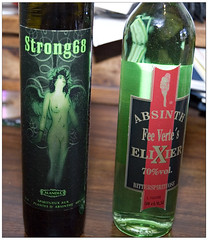A drink whose reputation is better than the drink itself, at least in my limited experience. Would I drink absinthe again? Sure. Will I travel over tor and dale to track it down? Probably not. Maybe I just didn't drink the right cocktail, as Harold McGee explains:
The Curious Cook : Trying to Clear Absinthe’s Reputation
While absinthe is still banned in this country, it is easy to buy over the Internet: Its reputation, however, remains as cloudy as the cocktails that are made with it.READERS of Ernest Hemingway know “Death in the Afternoon” as a book about bullfighting. But to drinkers with a taste for obscure booze, it is also a cocktail that Hemingway contributed to a 1935 collection of celebrity recipes. His directions: “Pour one jigger absinthe into a Champagne glass. Add iced Champagne until it attains the proper opalescent milkiness. Drink three to five of these slowly.”
When I heard about this concoction last week and wondered how Champagne bubbles would fare in the milkiness, I couldn’t just go to my local liquor store and buy absinthe. I had to substitute one of the anise-flavored alcohols that took absinthe’s place when it was banned in France and in the United States about a century ago.
Today absinthe is legal again throughout Europe, and while it is still banned in this country, it is easy to buy over the Internet. Its reputation, however, remains as cloudy as the cocktails that are made with it. Some welcome clarification has now arrived in the form of a new study by a team of German chemists and physicians.
Absinthe is a distilled spirit flavored with a variety of herbs and spices, primarily wormwood, an aromatic, bitter shrub. The key constituent of wormwood is a chemical called thujone, which gives it — and absinthe — a penetrating evergreen aroma. (Thujone is also a major component of the herb sage.) Thujone and the other aromatic compounds are what cause absinthe to become milky when it’s diluted. The aromatics are more soluble in alcohol than in water, so when the concentrated spirit is cut with wine or water, they cluster together in tiny droplets that reflect light from their surfaces. Instantly, what was a clear liquid clouds over.
Absinthe became tremendously popular throughout Europe in the 19th century. It was blamed for causing hallucinations, mental instability and criminal behavior, which medical authorities attributed to thujone. This belief helped get absinthe banned. But according to the new study, by Dirk W. Lachenmeier and colleagues, the modern medical consensus is that absinthism was either simple alcohol poisoning — some absinthes were 70 percent alcohol, nearly double the strength of most distilled drinks — or caused by methanol and other toxic adulterants found in some cheap absinthes.
Thujone is true to its reputation in one respect: it does turn out to have unusual pharmacological properties. It interacts with several neurotransmitter systems in the brain, including one that is also activated by the cannabinoids in marijuana. But while absinthe will get you drunk, it won’t make you stoned. In one experiment, a dose of thujone equivalent to a pint of absinthe lowered the subjects’ performance on attention tests and made them more anxiou

